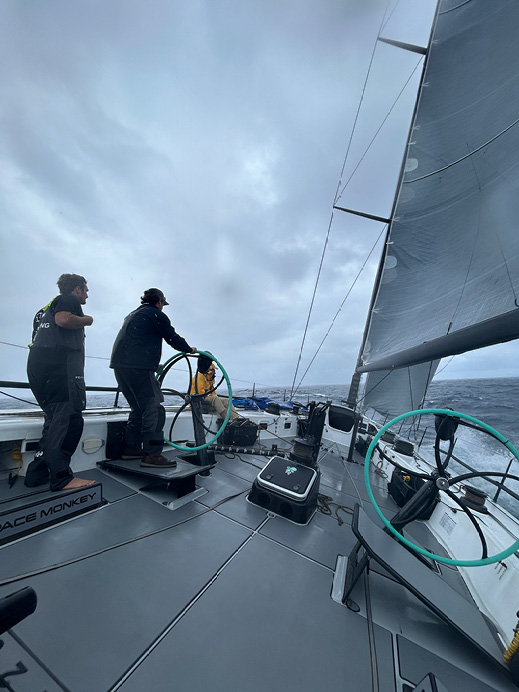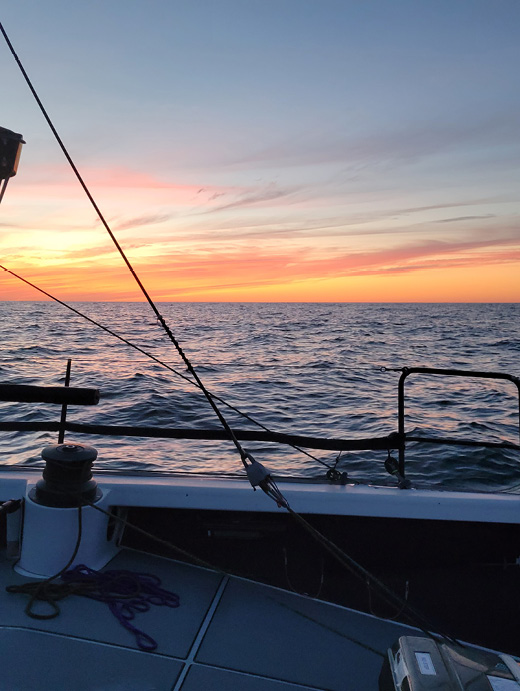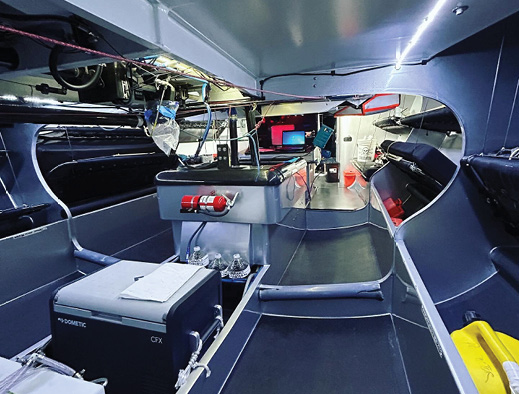By Jonathan Russo
In the early morning hours, there were more than a few times I thought the boat might break apart. The sound of the flat-bottomed boat crashing into the waves was alarming, as was the curling water frequently scouring the deck before flooding the cockpit. We would all be tossed into a dark, roiling sea, far from shore or rescue. To chase this thought from my consciousness I looked around the red lit space at the captain who sat at the navigation station, watching a computer screen. The other all-pro crew, equally unconcerned, were bunked in their pipe (small) berths, peacefully sleeping or reading from their devices. I assured myself my alarm was unfounded.
This was day four of a five-day delivery on a 68-foot racing sailboat from Newport, RI to West Palm Beach, FL, a journey of some 1,200 miles.

Leaving Newport astern © Brenden Conway
This journey was some of the best sailing I ever experienced. Helming a fast boat (we often did full days at 17 knots, often at over 20) was exhilarating. Sun rises and sets were the changes that signified the passing of time. The motion of the boat was the only constant. Scrambling onto the deck, after three hours of sleep, in full foul weather gear to start my watch deepened my appreciation of the hardships sailors have endured throughout history. Watching dozens of dolphins escort us on our way opened my eyes to the majesty of the marine world.
Delivering boats is a maritime hybrid. The goal is to take a boat from place A to place B as fast and efficiently as possible. This is not pleasure cruising. Whether power or sail, the owner wants to find their boat safely in the new location with as little wear and tear as possible. Also, time is money, a nautical meter is running for crew, fuel, and provision costs, thus speed becomes an important issue.
Of course, weather is always the dominant factor. Everything flows from the forecast. Getting beat up offshore is never a strategy for a successful delivery. This is why there is a flurry of activity after hurricane season in New England to take boats south where they can be used for the next six months.

Sunset off the Florida coast © Jonathan Russo
The person leading us south was Rhode Island native Jesse Fielding. He is the very definition of a pro sailor. His living is made by all things nautical; representing owners, captaining race boats, navigating, or as part of a crew. He also advises on yacht purchases and maintenance. His newest venture is Open Ocean Racing, a program that facilitates step-on-step-off regatta participation.
I love being on the water. Daysailing on a small engineless sloop, motor boating to a distant island for the night, crossing oceans in superyachts…it’s all good. That is why I jumped at the chance to join Jesse and his crew of nine to “help” on this offshore delivery. By help, I mean lend a hand where needed and steer if conditions allowed, but mostly just to come along.
Fortunately, I have been in the open ocean a few times: sails to Bermuda and back, one from Halifax to St. John, a few 600-mile races around eleven Caribbean islands, and several voyages to Maine from Long Island, so I knew roughly what to expect.
But a delivery is different. Here’s why.
On-Shore Organization
Pre-voyage planning is critical. Every aspect of the endeavor must be planned down to the last detail. All boat systems must be in working order. This trip was delayed several days while engineers rebuilt the pedestal grinder-powered hydraulic pumps which, in turn, enabled the six massive winches. Electronics and navigation systems were tested and reprogrammed as necessary. Sails were inventoried, with unneeded ones trucked south in a container that meets the boat wherever it goes. Crew arrival and accommodation was coordinated. All provisioning of food, medical, and safety gear was checked and put on board. At times, the Hinckley Yacht Services dock in Portsmouth, RI resembled a Cantonese wharf with its flurry of comings and goings, people laden with all sorts of equipment and supplies.
Weather and Navigation
The word “window” came up often. Jesse used Expedition software to analyze government weather files. He was looking for patterns that would not only keep us out of horrendous conditions but also allow us to head south without battling in-your-face winds and seas. Motoring in a sailboat is its own form of punishment, but can be made even more uncomfortable by wind-driven mountains of head-on waves. We wanted a northerly or easterly wind in order to reach down the Eastern seaboard. (Cape Hatteras juts out into the ocean and is the point that must be avoided by heading east before turning south.)
Once underway, a keen eye was kept on the weather graphic display for unusual or building isobars signifying a storm system. If one developed, a “bailout” course into Savannah or Charlestown until it passed, was plan B. Being in a sailboat meant the weather affected our course on an hourly basis, so Jesse remained glued to the computer in the nav station, monitoring wind direction so sail and course changes could be anticipated.
The Crew
The next critical component is the crew. This was an eye-opener for me. On the delivery there were nine professional sailors, one enthusiast looking to increase her offshore experience, and myself. Aside from the above-mentioned offshore time, I am a weekend cruiser and club racer. At 72, I was the oldest on board, but just barely, as one of the pros was in his seventies. The rest were in their mid-twenties to forties.
What astounded me were their skill sets: engineering grads from top universities who could fix the water maker and repair the electrical systems; maritime grads with advanced degrees; IT professionals who could troubleshoot computer issues without scratching their heads; and helms people who could steer an intended course at 22 knots in a confused sea of six-foot waves.
Everyone was kept on a watch system that varied with the demands of seamanship required by the conditions and time of day. If we motored in the daylight, only three of us were required on deck. At night with wind in the mid-teens, six were on watch.
What was also amazing was how everyone got on. Professional crew know that interactions must be kept helpful and friendly. One “bad apple” on a boat in tight quarters for days on end creates unnecessary tension. My shipmates were not only great companions, but also inspiring. For example, watching them make a complicated nighttime spinnaker change was like watching a ballet, so well-choreographed were their hands and feet in response to instructions from Jesse.
If you like to be surrounded by talk about boats, deliveries are for you. I heard endless conversations about this or that boat, this or that race. Amongst all the crew there was hardly a boat worth sailing they did not have a story about. That went for owners, too.
Housekeeping
Eleven people confined in a small space requires some serious thought as to the basics. Since this was a race boat, there was no common space to sit in. The entire bow was a sail locker. Port aft led to a small galley and a head was to starboard. Then came the pipe berth sleeping quarters. All meals were cooked on a camp-style two burner butane stove. Mealtimes were an individual choice. It was not unusual for someone to have beef stroganoff for breakfast. Not being an outdoors person, I was amazed at the variety and quality of freeze-dried food. Who knew coconut curried chicken was now an option? There were also more traditional options such as cold cuts for sandwiches and breakfast cereals. The dessert selections ranged from candy bars to copious quantities of baked goods. No alcohol or any other intoxicant was allowed.
Comfort is not a concern. For example, the massive sails were taken out of the bow sail locker and laid on the floor amidship. The goal was to keep weight out of the bow. However, by placing the sails there the already ultra-low headroom in the sleeping area was further reduced. As a nod to this, there were signs saying “Ouch” at the spots where hitting your head was predictable.

Tidied up sleeping quarters © Brenden Conway
Landfall
After five days at sea, the Florida coast came into view and we angled toward it. Jacksonville’s skyline reminded me that my land-based life was soon to resume.
In the dark of night, Jesse led us safely through the harbor channel at West Palm and onto an open pier. The delivery was complete. I imagined how pleased the boat owner would be. There were no injuries, no one had been incapacitated from seasickness, and nothing of any consequence broke.
As I stepped ashore, I was left with a deep appreciation for the sea, the boat, and most of all Jesse and the crew. The privilege of witnessing and participating in this delivery with so many pro sailors was one of the most memorable nautical experiences in my forty years afloat. ■
Jonathan Russo has been writing about sailing for over three decades. He pens the “Afloat” column for the Shelter Island Reporter. His other sailing stories have appeared in Soundings, Worth Magazine, The NY Observer, Down East Magazine, Messing About in Boats, Scuttlebutt, and Hampton Cottages and Gardens. He sails his 1993 Sabre 38 and his wife’s Etchells out of Shelter Island, NY.




